

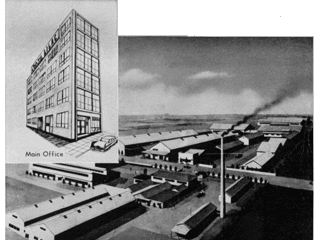
Marusho Head Office in Tokyo and Factory in Hamamatsu
Accuracy: While I believe the version of Marusho's history below, there are several problems in pinning down the absolute chronology. First, we're dealing with a period of over 30 years ago and most of the action took place in Japan. What little there is in print in English about Marusho suffers from (a) all the research difficulties that I now have and (b) the fact that much of it was written by professional authors and not enthusiasts, and edited by an editor. I have contacts in Japan who have supplied me with many useful materials and translations, but even the Japanese press is often inaccurate. Further, some things simply don't translate well.
Whenever possible I have relied on company literature or on interviews with the principals in the saga. You will see notations in the text where significant differences of opinion arise. This Web page has the story as I understand it after doing the research for 25 years, but I will gladly change anything in it if you have better facts....Ralph Walker
According to one magazine Masashi Ito, founder of Marusho was born March 16, 1922. The author didn't think it odd to then say that he worked from 1930-1935 at Soichiro Honda's automobile repair shop. In a more authoritative article Ito is said to have been born in 1913 (since backed up by another source), and that Honda was 6 years older. Sadly, Mr. Ito died on March 23, 2005 and his age was given in the announcement of his death as 92, so the birth date of 1913 seems correct.
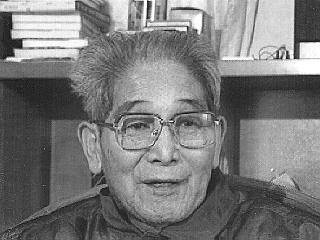
Masashi Ito, President of Marusho, in 1992. Photo taken from videotape, © Shizuoka Broadcast System.
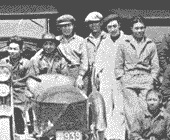 Honda was 21 when he opened his repair shop named
ART in Hamamatsu in 1928.
This photo, owned by Ito, shows him seated in
a Harley sidecar in front of ART in 1931 or 1932, with Honda fourth
to the right from Ito (with both hands in his pockets).
Honda was 21 when he opened his repair shop named
ART in Hamamatsu in 1928.
This photo, owned by Ito, shows him seated in
a Harley sidecar in front of ART in 1931 or 1932, with Honda fourth
to the right from Ito (with both hands in his pockets).
About 1935 Ito and an older brother opened their own repair shop but they sold it when World War II began. In 1946 Ito opened his Marusho Car Repair Shop and a facility that made truck bodies for Toyota and Nissan, but his real interest was in making a motorcycle, an enterprise that began in 1948 with the establishment of the Marusho Shokai Co., Ltd.
A successful prototype, named the ML and sometimes referred to as the LA, was completed in 1950 (not in 1948 as some articles state). Mass production of this ML series 150cc single, patterned after a pre-war Zundapp and utilizing Marusho's trademark shaft drive, began in 1951 as the Model LB and later the LC. Also in 1951 the name of the company was changed to the Marusho Motorcycle Industrial Co., Ltd. Between 1951 and 1961, when bankruptcy temporarily closed the factory, Marusho was to build 31 models of motorcycles under the name Lilac, all but 2 of which were shaft-driven. Incidentally, the name 'Lilac' was chosen because it was Ito's wife's favorite flower.
Tokyo Toyota was the agent for Marusho when production began. Output was 30 machines a month by 10 employees in the Hamamatsu, Shizuoka factory (Honda's factory was also in Hamamatsu). The models LB and LC proved successful and were followed by a succession of upright singles of 90cc - 250cc including the very popular JF Baby Lilac step-through and two 350cc opposed twins. In 1955 Marusho moved their head office to Tokyo with 60 employees, while the Hamamatsu works had 600.
A racing version of the 250cc single SY, the SYZ, put Marusho on the map. In his premier race, sixteen (also reported as fifteen) year old Fumio Ito, also reported to be named Shiroo Ito, and who was to become the most famous Japanese rider of his day, won the first All Motorcycle Endurance Road Race, also named the 'All Japan Volcano Scramble Race' and also referred to as the '1955 Asama Road Race' and the 'Asama Kogen Factory Endurance Race'. Whatever it was called, the Lilac SYZ won the Light Class and Marusho's 90cc entry won 2nd place in the Ultra Light Class.
The years 1955-1960 were the best years for Marusho, and indeed for many other small Japanese motorcycle companies. Actually, Marusho was by no means small, producing 8,091 bikes in 1955 and 11,241 elegant and advanced bikes in their best year, 1959. The successful 250cc SY rapidly evolved through 4 more body styles, and scaled-down versions in 125cc-175cc were produced. The JF Baby Lilac was not selling well and so was replaced with the DP Baby Lilac, which also did not sell well.
In fact, Lilac's designs were several years behind Honda's, so in 1959 the time was right to re-work the entire product line. This came at a time when Honda was looking unbeatable and the Japanese government was actively seeking to rationalize (reduce the number of of manufacturers in) the vehicle industry.
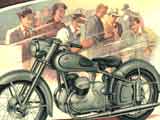 The dated 125cc and 250cc singles were upgraded to
elegant V-twins, probably inspired by the design of the 1953-1955
German Victoria Bergmeister 350cc (pictured).
This image is a 770x600 pixel fairly high resolution JPG, taken from an advertising brochure.
The V-twins proved very popular.
The Baby Lilac line was replaced with a sleek 50cc scooter, the
AS-71.
The dated 125cc and 250cc singles were upgraded to
elegant V-twins, probably inspired by the design of the 1953-1955
German Victoria Bergmeister 350cc (pictured).
This image is a 770x600 pixel fairly high resolution JPG, taken from an advertising brochure.
The V-twins proved very popular.
The Baby Lilac line was replaced with a sleek 50cc scooter, the
AS-71.
Mitsubishi Nippon Heavy Industries, Ltd. was having trouble selling their Silver Pigeon scooters and struck a deal with Marusho to produce the sleek AS-71 under the name Silver Pigeon Galepet. On the strength of an agreement to loan Marusho ¥300,000,000, Ito spent ¥150,000,000 on plant and equipment. Mitsubishi originally had agreed (or estimated) to sell 10,000 AS-71s but lowered the figure to 6,000 and then 3,000. Finally they cancelled the agreement, having come through with only ¥50,000,000.

The Marusho and Lilac assembly lines (from factory photos)
Ito had borrowed heavily to finance factory expansion. Output would have been 27,600 units a year. It is unlikely that production of the scooter actually began since only one example is now known to exist, but production of the V-twins was in full swing at the old plant. Retooling had been an expensive undertaking. When completion of the new plant, which was to have been ready by April 1960, fell behind, Marusho, now with no support from Mitsubishi, was unable to pay its obligations. Marusho had lost their agents, who refused to carry their products after Marusho's deal to sell through Mitsubishi, so Marusho was unable to market their motorcycles except to individuals who were willing to pick them up at the factory.
In California, the M-C Supply Co. (the name stood for 'Magnera-Clawson', the partners) began importing the V-twin line. The models imported were the 125cc CF-40 ($495), the 250cc LS-18 ($595) and the 300cc MF-39 ($695). Would you pay $100 more for a 250 rather than a 125? Almost everybody said yes. The CF-40 is thus rare, the LS-18 common and the MF-39 moderately rare. The CF-40 and LS-18 were also available in Japan since they were standard displacement models, but the sport model MF-39 was not. An identical bike with 250cc was marketed there as the LS-38. These were good bikes with expensive features. All were shaft-driven with 2 batteries and massive dynastarters, starting the engines by turning the crank directly. They were quiet and basically reliable by 1960 standards. Weak points on the bikes included pistons (manufactured by ART) that expanded at too great a rate for the cool-running engine design, an iffy engine lubrication scheme and too-tight setup.
M-C may have imported as many as 800 (the author believes the total to be half that) in 1960-1961, but that number was not sufficient to solve Marusho's cash-flow problems. Marusho declared bankruptcy October 12, 1961 with a debt of ¥1,700,000,000. That was the end of M-C's involvement in Lilacs. M-C was a well-known accessory distributor before and after Lilac.
In 1962 Ito became a subcontractor for Honda and began paying the company's debts. A very few bikes were pieced together during '62-'63 while the assembly lines were shut down, and some prototypes were developed (C-103/C-105, M-330). Many of their designers moved to Bridgestone and Honda and the Lilac influence can be seen especially in the Bridgestones. Perhaps this influenced Honda's later acceptance of shaft drive and even the transverse configuration of the V-twin Lilacs. . .
The company was reorganised in 1963 as the Lilac Co., Ltd., and returned to production in 1964 as a much smaller company, primarily to build a large opposed twin for the lucrative American market.
A deal was struck with importers in California who organised the U.S. Marusho Corp. It was incorporated May 26, 1964 by Genichiro Roy Hiraishi, with Tsuneo Tom Nakamura listed as the vice-president and Akira Kawasaki listed as secretary-treasurer. Roy Hiraishi ran the enterprise. Roy Hiraishi passed away in 2002. I have been in touch with his son in recent years, who also works in the automotive design field.
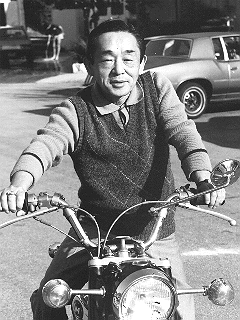
Roy Hiraishi, President, U.S. Marusho Corp., astride Tad Takasu's (CA) Marusho Electra in 1985.
Lilac had not built a 500cc bike before, but had built two 350cc flat twins, the TW Dragon and SW Lancer. In addition they had a beautiful pair of 125cc and 160cc prototype flat twins, the C-103/C-105. By scaling up the frame and transmission of the 250cc/300cc LS-38/MF-39 series, and copying the reverred BMW /2 500cc engine the new Marusho could be on the street in short order.
All but about 50 of these 'Marushos', as they were called, were exported to the U. S. Those few destined for the home or Australian market were designated the Lilac R92, using the name already familiar in Japan. The agreement with U.S. Marusho called for 100 Marusho model STs per month, a figure that was never met. For that reason there was no surplus to be exported to other countries.
The ST ('Sport Touring') was a stylish, well-proportioned and sporty bike very much like the LS-38/MF-39. The engine appeared to be an exact copy of the BMW but, in fact, only some internal parts were interchangeable. Lilac was careful not to infringe on BMW patents, used entirely different ignition and electrical systems and used their own style of transmission and clutch, developed over 14 years of building shaft drives. While they may have been ridiculed for copying a western style, other companies, notably BIM and DSK, had copied the entire BMW motorcycle. It was traditional in Japan to emulate the masters, and the masters were the Europeans.
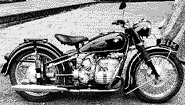 Photo © Kikuo Iwatate
of a Mr. Yoshinari's BIM, 1986.
Photo © Kikuo Iwatate
of a Mr. Yoshinari's BIM, 1986.
The ST was produced in black with a silver headlight, rear fender and single right-hand toolbox. Candy-apple red was an option. A decent number, 600, were produced for the 1965 model year but problems surfaced in 3 main areas: Ring gears (made in Sweden), generators and -- this is what killed the Marusho -- the advance mechanism. A fix that worked for the advance mechanism was to substitute the BMW part, at a cost of $35. Hiraishi tried to get Lilac to do so but neither party was able to absorb this extra expense, a source of contention. Dealers and the importer were forced to cannibalize new bikes for parts. Many cannibalized bikes were then never sold, accounting for the relative ease with which a Marusho could be completed years later. The ST sold for $995.
For 1966 the color scheme was changed to all black (or optionally candy-apple red), compression was increased, cylinders painted black like the BMW R69S and carb size increased from 22mm to 28mm. 180 of these 1966 model Magnums were built. The price remained $995.
An upgrade was designed by Hiraishi in California, consisting of electric start, heavier cylinders and an oil filter, for the 1967 model year. BMW would introduce electric start only 3 years later with the /5 series. Only 123 of these aptly-named Marusho Magnum Electras (now $1195) were built for model year 1967, with the last few going to Australia. The numbers speak for themselves: 600, then 180, then 123 bikes per year. Lilac could not remain in business. As an aside, the last known example of the Marusho/Lilac company's many thousands of bikes, Electra F9-1123, today resides in Western Australia and is licensed and in use.
Lilac folded as a motorcycle manufacturer for the second time in 1966 (or 1967 - exact date unknown) after producing the 1967 Electras. Ito's family fortune went toward paying the company's creditors. Ito retired and said goodbye to the remaining 30 employees. Another Lilac employee took over the company which reportedly then produced rice cookers and continued to pay off old company debts.
Ito lived until his death in 2005 in a small Hamamatsu apartment building (named 'Lilac-so'), which he owned. He was the honored guest at the twice-yearly meets of the Japan Lilac Owners Club. With the recent death of Soichiro Honda the Japanese media has recognised the importance of these two pioneers of the Japanese motorcycle industry. Ito reflected in an interview that the difference between success and failure was very small. Lilac was not a failure as a manufacturer, but did fail as a business. They had the expertise and the products and could easily have duplicated Honda's success given a few twists of fate.
Marushos are extremely easy to restore. For example, only one spoke size is used. A Honda Dream has 4. The bike comes apart with simple tools -- no drilling out of stubborn screws. The castings (hubs, engine, transmission, bevel case) are unfinished and can be cleaned with naval jelly -- no bead blasting is required. The bikes are usually black -- an easy color to deal with. Many parts are polished aluminum and can be brought to life with a little Simichrome. Most used a Honda taillight, and a few BMW parts, such as pistons, can be used. Marushos are pretty, fast (compared to a BMW 500) and have at least average handling and ride.
On the question of market value, it is true that they are not classics and probably will never command overly high prices. But there is a great revival of interest in Japan in early manufactured products. Since the Marusho, and especially the last model, the Magnum Electra, was the largest and last product built by a very prominent firm, they have become desirable in Japan, and that has affected their value in the U.S. And it is possible that Marushos will achieve fad status sometime. A number of recent Marusho sales have netted several thousand dollars but as with anything, condition and correctness is all-important.
Many of the comments in this section apply also to Lilac V-twins, but the Vs are more complex and are much less rare, though they are scarcer in the U.S. Australia just happens to be the home to most of the early 250cc V-twins. Like the Marusho, you can disassemble one with simple tools and you can buy one without a long search or much money.
Perhaps 50 people in the U.S. are
actively involved with these bikes. The Lilac Owners Club in
Japan has a good turnout for their regular meets. There are a
scattering of owners in other countries. There are 2 very
early Lilacs in California. The majority of U.S. bikes were on
the West Coast and in a band from Minnesota to Pennsylvania and
north to Massachusetts, but with the advent of the WWW, and ebay, they have been migrating to all corners of the US and to many new countries. I
know the names of most of the owners and can often tell you history about a given bike that you may not be able to learn from a seller. I also reprint manuals and refer restorers to others
who can supply parts.
Site Map